- This topic has 142 replies, 6 voices, and was last updated 8 years, 7 months ago by
Giulio TiberinI .
-
AuthorPosts
-
10 April 2015 at 18:23 #5782
Is’ a good idea to try.
19 April 2015 at 23:57 #5811He continued excavation in search of depth and parable, I must say that it is more difficult than I thought, apart from the depth to be reached that is in itself remarkable, the biggest difficulties I am encountering in trying to maintain a next figure to the parabolic while deepen areas.
They had to spend sooner than expected to be sub 70 mm, one from 120 It is no longer able to correctly follow the curvature in the median zones, while it is still effective in the vicinity of the center and the edge.
At the moment I am at a constant conical (estimated) between -0,7 e -0,8, the figure is clearly still “fierce”, in photographs the comparison with the simulation for K =-0.75, This is a good time to switch to the measures with Foucault.


Note that the Ronchi grating returns a figure “readable” as it is composed of only 2 Linee/mm, a standard pattern from 4 or more lines with this focus is almost unusable.
At this point you change your strategy by reversing the order of the depth of the zones, as mentioned try to bring to measure before the outer zones to then proceed towards the center.
28 April 2015 at 1:59 #5824poor week of scratching, only a few sessions just to increase the depth until about -0.9 conic constant.
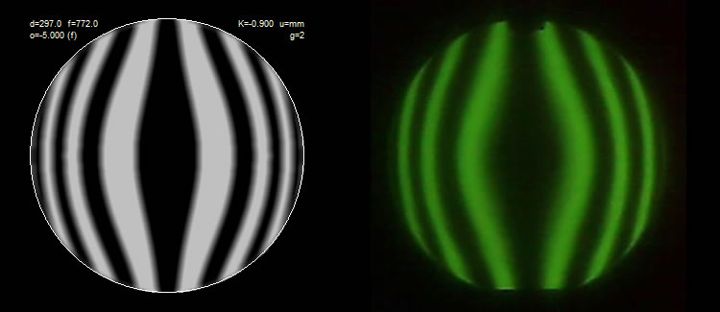
Tomorrow, Intensive evening with Foucault to proceed in small steps over the parable
 towards the constant hyperbolic -1.12.28 April 2015 at 11:27 #5825
towards the constant hyperbolic -1.12.28 April 2015 at 11:27 #5825thorny but very interesting path !!
 30 April 2015 at 16:00 #5826
30 April 2015 at 16:00 #5826Start of Foucault test:
As expected by many, the tester with a fixed source on this focal point is totally unusable, you can not take any measure, maybe the first two inland areas and with great difficulty ( and imagination ), but otherwise there is no history…

So I modified the tester “slitless” and the music is changed for good fortune !

The slitless allows you to effectively use the entire longitudinal extent of the drawings, the mask holes always remain illuminated, I felt much more sensitive, a shift of only 0,1 mm is already evident in the shadows of display differences.
However, the short focal length does not generate a homogeneous darkening in any area of this sector, the shadow's edge is always visible within the same area, who, the approach of the relative ( the Ham ) center of curvature, It assumes a less defined and is more similar to a gradient which makes the shadow at least more “nuanced” e “spread”.The difficulty is to perceive the moment in which this gradient assumes the same appearance in opposite sectors of the same zone, with a little’ of luck and practice, I believe we can also groped to make reliable measurements, with the limitation of not claim to measure the “lambda/8” or so…
Having said this report the results of the first series of measurements, with Couder mask 7 zones, and central obstruction of 115 mm, obviously we are still far dall'iperbole with conical constant -1.12 ( circa ).

First verification of results, to test the reliability of the same measures and inevitable operator evaluation errors, I simulated the Ronchi graph with the results of eddy measures, comparing it with the last Ronchi test “real” executed.
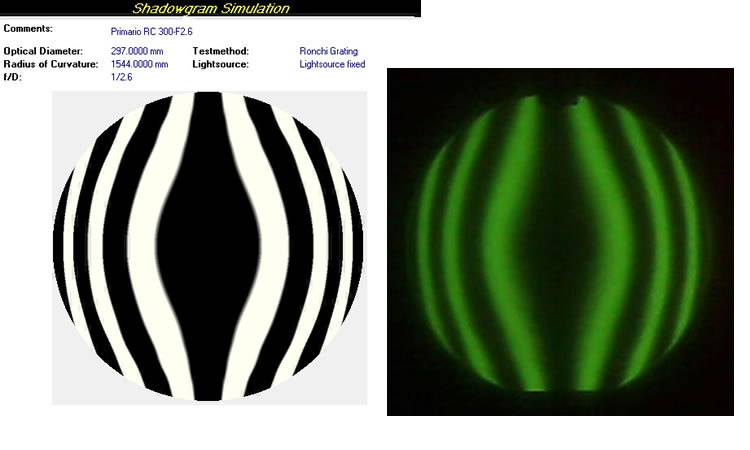
The simulation seems to confirm the goodness of readings, if we carefully examine the real image of the Ronchi can be noticed in the outer areas exactly the same defects calculated by the simulation, clearly the real image are less immediate, because the printed pattern on shiny joined to the low resolution of sunshine 2 lines / mm tends to mask the finer details.
The central area instead shows some difference, There is, however, to consider that the blocked area was not measured, and that the software in the absence of these data creates an interpolation between the first measurement available and the center mirror.Next step will be to continue the deepening of external areas, trying to eliminate the visible defects and groped the entrance inside the “"trumpet bell"”.
1 May 2015 at 15:22 #5827Before proceeding further, it is better to eliminate the defects in order to achieve a more regular curve on which then set the deepening in sequence starting from the last outdoor area.
I intervened Area 6 with subs 70 mm, and on 2-3-4 with subs 120 carry them further as required to return a more regular trend of the curve, with the consequent decrease of the remaining zones accompanied by a small and predictable general return towards the ball,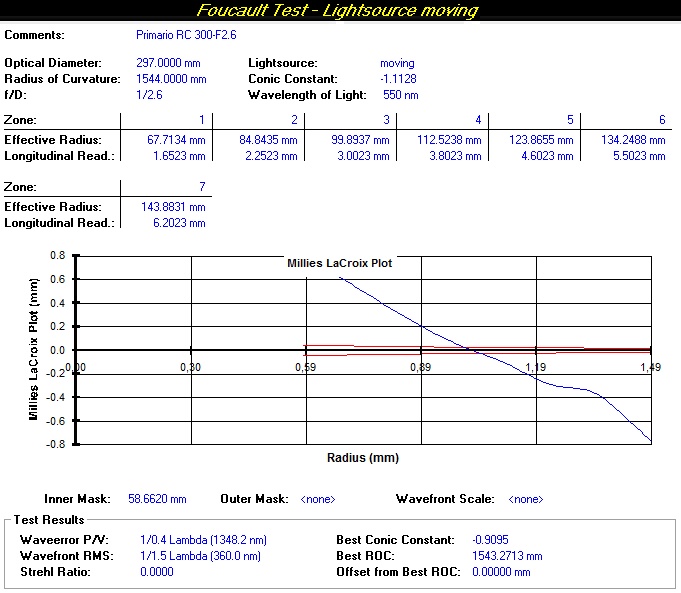
Ronchi simulation with data readings of Foucault, compared with the real Ronchi.
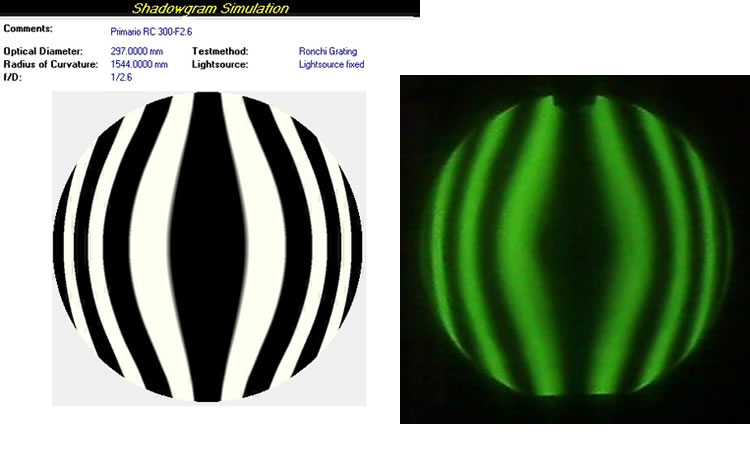
This does not need to much for the final figure, but it serves to better manage the sequential depth from the edge toward the center.
The method used in fact plans to hold good for the edge and deepen everything else, in other words it means to translate the curve on the graph in this way Ml: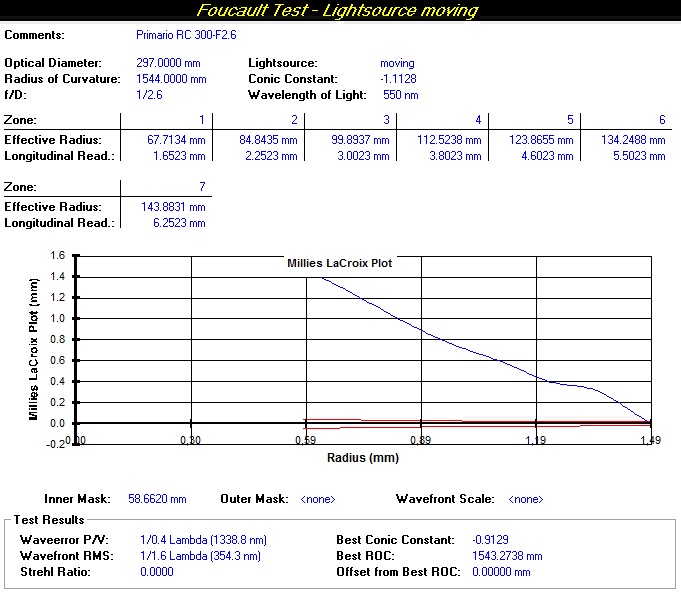
Reading the chart in this way you see immediately the in-depth work of all the remaining regions with respect to the edge, it's enough “tear down” all areas starting from the penultimate to obtain a beautiful straight line ( simple no ?

Is’ definitely a longer route, but I believe that gives the best guarantees and adapts better to the diameter of the sub-features, especially in this case in which the peripheral zone is the most important given the high obstruction at the center.in short a complete and detailed description of this method for localized in article dedicated court.
 1 May 2015 at 18:22 #5828
1 May 2015 at 18:22 #5828I share the brilliant reasoning. It is a good strategy that does not point to saving time, but raggiungimeno a good result with the least risk, given the considerable objective difficulties.
1 May 2015 at 18:54 #5829It Giulio, It is an ingenious reasoning , But unfortunately ( Leg ) I did not invent it
 .
.
I simply “spied” overseas as the most famous designers work short focal lengths with this method, including Gordon Waite…3 May 2015 at 0:00 #5831Hi Massimo,
what to say…You are proceeding with care and with clear ideas…keep it up…Meanwhile, we await further developments…
I wanted to ask you a question:
Generally how long (or turns of the table) works on every single area before proceeding with new measurements?
in addition if the work consecutively the various zones, as it decides how much time to devote to each zone?
Ad is 1 around in the area estrena, 2 in the penultimate, 3 in that even more internal etc.…or devotes approximately the same time to each zone?
I'm not talking about when you correct errors zonal, but as you progress you closer as evenly as possible to the parabola or hyperbole in your case…3 May 2015 at 4:16 #5832Not less than 10 rounds of small table with divers and at least 25-30 minutes with the sub 40% before a new measure, I saw that with a lower amount of work there are no appreciable changes, but I think it depends very much on the way you work.
Concerning the sequences for the deepening, I did not follow a precise pattern, usually beginning in a way “to taste”
 , that could very well be what you said, for a session, then verify the results to ronchi and try to assess where the figure is moving away too much on the performance parabolic, then act accordingly to bring the figure toward a more regular curvature before resuming the deepening.
, that could very well be what you said, for a session, then verify the results to ronchi and try to assess where the figure is moving away too much on the performance parabolic, then act accordingly to bring the figure toward a more regular curvature before resuming the deepening.In fact, I tried to build the parables “partial” ellipses, or if you prefer to step -0.1 conic constant, which in addition to being a good way to take more and more familiar with the sub-diameter, I believe they are above all a good workout ahead of the final corrections, in practice while it deepens correct errors, to arrive at the final stage by continuing to do the same things that he did during the entire route.
In this last phase instead a work area at a time or at most two adjacent, “pulling down ” until they are inside the tolerance trumpet ( at the moment I'm still working the area 5-6 con sub 70 mm and alternating a few laps with sub 120 mm on the central areas not to flatten the center too) .
Measurements with Foucault after 10-15 laps lens table ( 20-30 minutes ).Clearly approaching the final shape of the interventions will be shorter and more frequent measures.
18 May 2015 at 22:19 #5891During the approach to the hyperbola, must of necessity, reach and then cross the parable with conic constant K = -1.
So I continued to “to dig” according to the modalities described previously, dl starting edge and alternating with some sessions at the center not to lose too much depth, trying to locate ( just for my curiosity ) time to “transit” of the conical in equivalent parabola for this focal.To date, the ML graph looks like this:

We are not far apart dall'iperbole project, but look what happens if the software simulation and comparison to the parabolic imposed constant value:

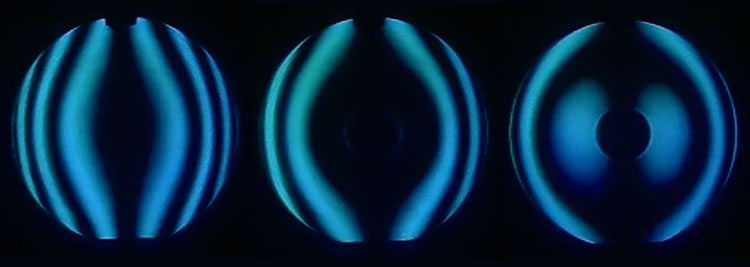
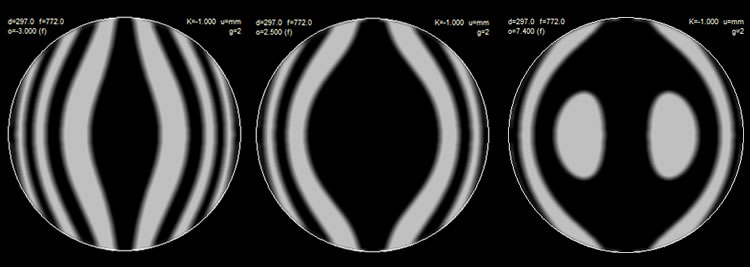
We are exactly in the vicinity of the parable, with a maximum error value of lambda / 4 and K =-0.99 , considering of course that Foucault with this focal length can not be used with precision.
However, even the comparison with the Ronchi simulation shows that the figures are very similar, except for some small local defect of the last hour…Is’ a pity that should not stop here
 , if you needed a parabolic mirror, at this point I could easily start of the caustic test to verify and improve the figure, Instead, proceed beyond this parable to get close to the constant infamous conical -1,1128 and proceed with the corrections ( and hope ) final. 21 May 2015 at 18:26 #5900
, if you needed a parabolic mirror, at this point I could easily start of the caustic test to verify and improve the figure, Instead, proceed beyond this parable to get close to the constant infamous conical -1,1128 and proceed with the corrections ( and hope ) final. 21 May 2015 at 18:26 #5900You're very close ……….
25 May 2015 at 15:48 #5908It astrotecnico, the figure is close to that final, although more it goes on the readings seem to become uncertain. Right now my estimate of “range” the reliability of the readings is 0,10 mm longitudinal stroke ( back and forth ), too many to demand a proper analysis .
Anyway, as you said , the important thing is to arrive at a minimum correction, also alleged, to continue with the most reliable of caustic tests.
Then, I started with the deepening from the edge:
-sub 70mm stroke Area 5 to increase the curvature of the zones 6 e 7 alternating with sub from 120 with short strokes and read, almost central, on the remaining areas to balance the consequent decrease of curvature and depth.After a session of outdoor areas 6 e 7 They seem to have finally reached the tolerance trumpet, As then this measure will be effective is to be verified:

At the moment, We take for this figure and good “we park” the area 6 e 7,
The next step is the deepening of the areas 4 e 5 with the same system of the increase of the curvature of the selected zones and simultaneous deepening of the center, Up to also bring in their tolerance.25 May 2015 at 17:49 #5909I see that the work is going well according to the ingenious strategy that you have set
 .
. In fact it is proving to be functional because you already have the most delicate work that theoretically ended; and the rest is labor intensive, but it should also be less dangerous
 28 May 2015 at 23:10 #5980
28 May 2015 at 23:10 #5980In fact Giulio, the road is quietly hardworking, It proceeds in small steps without major upheavals.
The following corrections made since the last report ( note: screenshots generated by the Foucault Test Analysis generate a graph of ML-scale error in the y-axis values, I did not understand why, but from now on the public to monitor directly the analysis instead it is correct ).
excerpt from “notebook of grattavetro” ( Giulius docet
 )
)– deepening of the area 4:
sub diameter 70 mm, slight pressure to the center,15 minutes with slow rotation.
sub diameter 115 mm no pressure, 5 minute media rotation.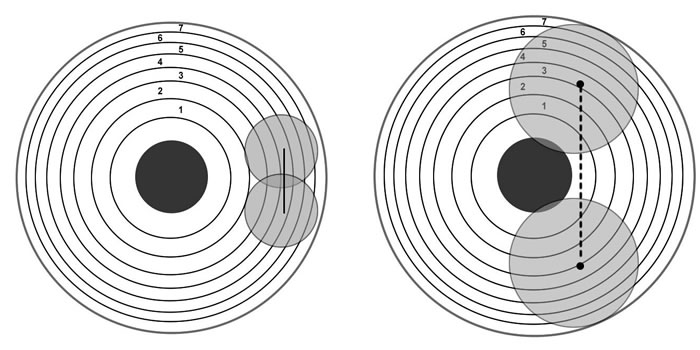
the latter type of use the races as a connection with the center for the outer zones, as I find them very effective as generated but excellent depth to make “smooth” and continues the surface and in the meantime to prevent the center to remain high.
resulting ML Chart:
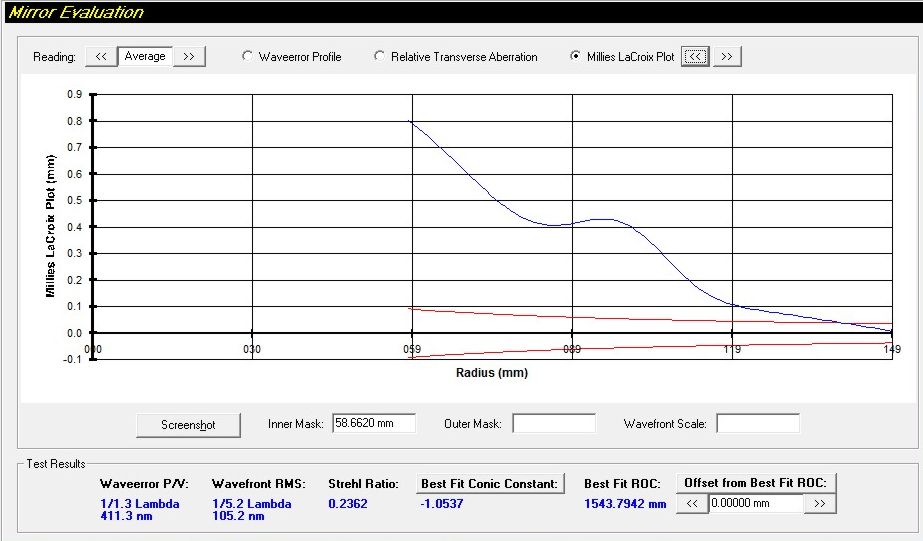
should be noted that the increase of the curvature of the outer zone to the machined corresponds to a decrease of the curvature of the inner.
– first “attack” direct access to the area 1 and subsequent slight deepening of the area 3
sub diameter 70 mm are zones “0”, normal pressure at the center, 20 minutes with slow rotation
sub diameter 70 mm are zones 3, slight pressure to the center, 10 minutes with slow rotation.
– usually connection 5 min with subs 115 mm.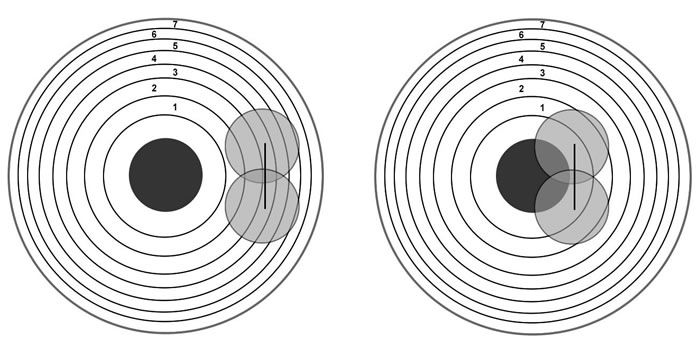
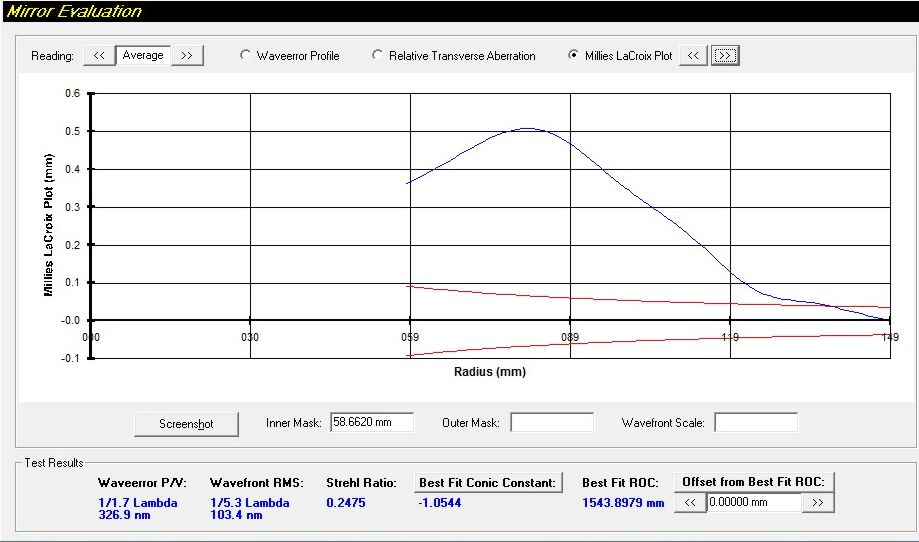
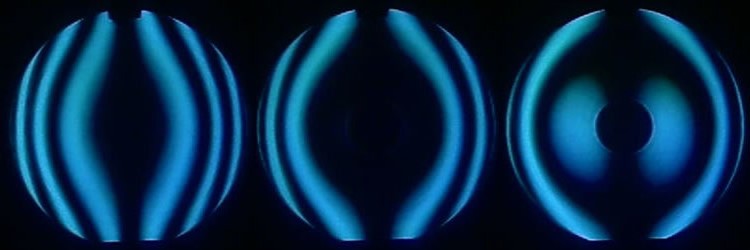
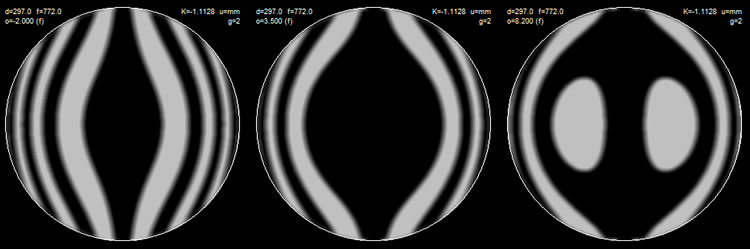
the Ronchi simulations refer to the final shape of the project with the conic constant -1.1128
the next step will be the deepening of the area 2 and then I think it's time for minor adjustments to the entry into the “"trumpet bell"”, always using the starting mode from the edge.
-
AuthorPosts
- You must be logged in to reply to this topic.